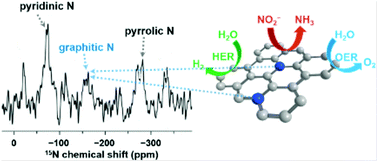Graphitic nitrogen in carbon catalysts is important for the reduction of nitrite as revealed by naturally abundant 15N NMR spectroscopy†
Abstract
Metal-free nitrogen-doped carbon is considered as a green functional material, but the structural determination of the atomic positions of nitrogen remains challenging. We recently demonstrated that directly-excited solid state 15N NMR (ssNMR) spectroscopy is a powerful tool for the determination of such positions in N-doped carbon at natural 15N isotope abundance. Here we report a green chemistry approach for the synthesis of N-doped carbon using cellulose as a precursor, and a study of the catalytic properties and atomic structures of the related catalyst. N-doped carbon (NH3) was obtained by the oxidation of cellulose with HNO3 followed by ammonolysis at 800 °C. It had a N content of 6.5 wt% and a surface area of 557 m2 g−1, and 15N ssNMR spectroscopy provided evidence for graphitic nitrogen besides regular pyrrolic and pyridinic nitrogen. This structural determination allowed probing the role of graphitic nitrogen in electrocatalytic reactions, such as the hydrogen evolution reaction (HER), oxygen evolution reaction (OER), and nitrite reduction reaction. The N-doped carbon catalyst (NH3) showed higher electrocatalytic activities in the OER and HER under alkaline conditions and higher activity for nitrite reduction, as compared with a catalyst prepared by the carbonization of HNO3-treated cellulose in N2. The electrocatalytic selectivity for nitrite reduction of the N-doped carbon catalyst (NH3) was directly related to the graphitic nitrogen functions. Complementary structural analyses by means of 13C and 1H ssNMR, scanning electron microscopy (SEM), transmission electron microscopy (TEM), X-ray diffraction (XRD), X-ray photoelectron spectroscopy (XPS), Raman spectroscopy, and low-temperature N2 adsorption were performed and provided support to the findings. The results show that directly-excited 15N ssNMR spectroscopy at natural 15N abundance is generally capable of providing information on N-doped carbon materials if relaxation properties are favorable. It is expected that this approach can be applied to a wide range of solids with an intermediate concentration of N atoms.



 Please wait while we load your content...
Please wait while we load your content...